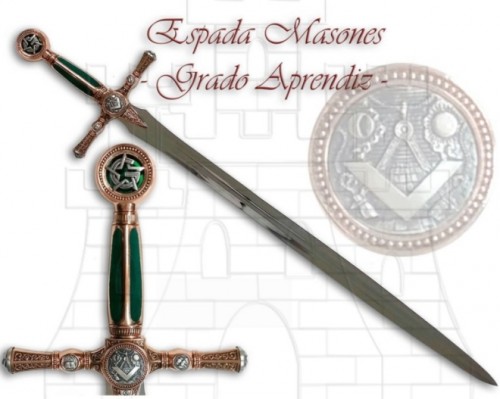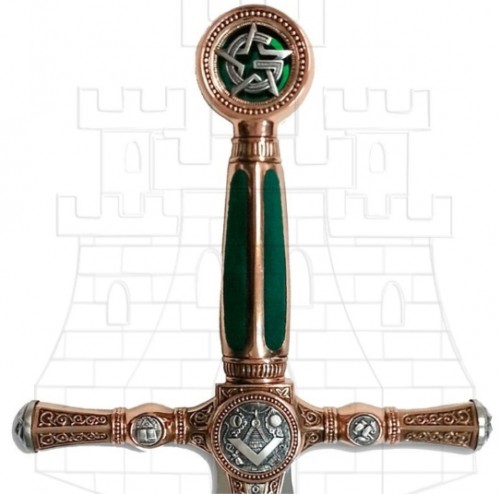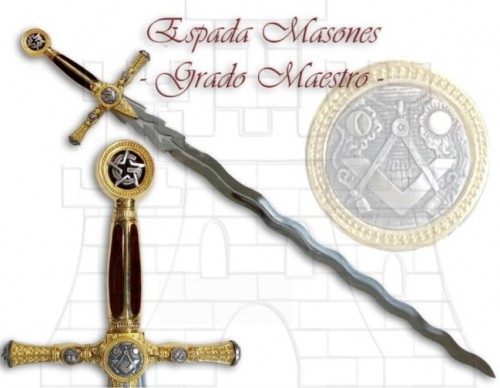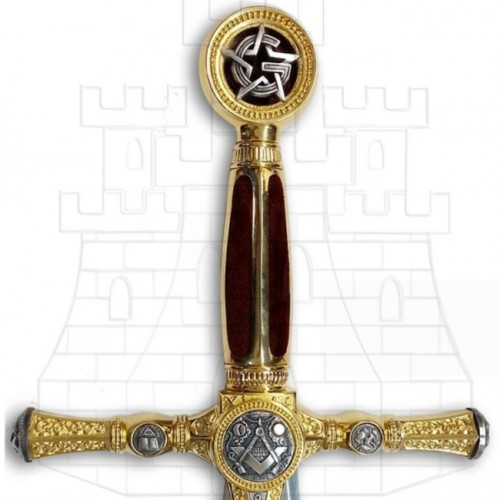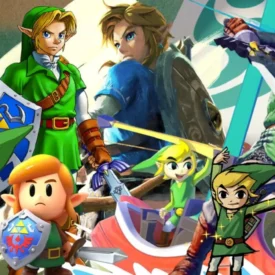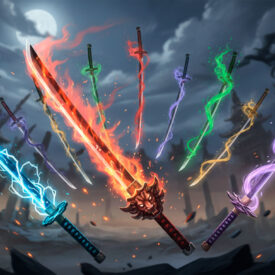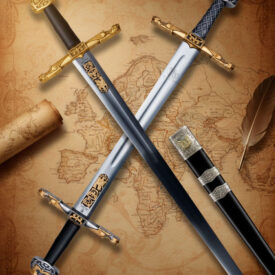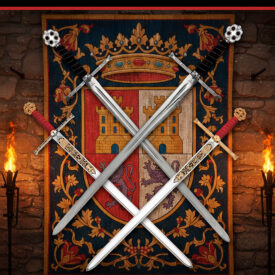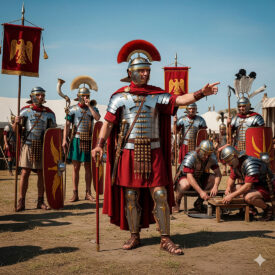A Blade That Does Not Cut Time: The Legend Behind Masonic Swords
Legend has it that, in the gloom of a lodge, the tip of a sword marked the beginning of an inner transformation. It was not a sword for battle: it was a mirror reflecting duties, oaths, and the light of knowledge.
Masonic swords are more than mere objects today; they are symbolic vehicles that traverse centuries of rituals, adaptations, and metaphors. In this article you will learn about their origin, their meaning in the different degrees, the most recognizable types, how they appear in ceremonies, and what physical elements preserve those symbols that so fascinate historians and reenactors.
From Guilds to Lodges: Degrees and the Relationship with the Sword
Masonry is structured in degrees that evoke the memory of ancient builders’ guilds. The sword accompanies this symbolic order, marking functions and responsibilities.
Apprentice: The Sword That Teaches to Measure
The apprentice degree is conceived as the foundational moment where the profane assumes discipline and attention. The sword, in this context, is not an instrument of combat, but of discipline and self-control. Its presence reminds us that words must adhere to reason and justice.
In ritual practice, the apprentice feels the tip of the sword on his chest during initiation: a symbolic gesture that suggests the weight of the moral commitment he is about to assume.
Fellowcraft: The Sword as Administrative Responsibility
The fellowcraft is he who participates actively in the life of the lodge. Administrative obligations and participation in collective work are characteristics of this degree. The sword accompanies the officers who ensure proper functioning: it serves to order, protect, and signify authority in daily life.
Master: The Flaming Sword and Authority That Does Not Intimidate
The master degree empowers the Mason to assume command and guidance. Here, the sword can acquire greater symbolic prominence: the flaming sword, for example, is the emblem of the Worshipful Master and represents science, virtue, and the transformative fire that drives teaching.
Chronology of Masonic Swords: Origin and Evolution
| Period / Date | Description |
|---|---|
| 17th Century (Origins of Masonry) | Masonry as a fraternal institution emerged in Europe and fully developed, as it is known today, around 1717 in England. |
| 18th Century (Consolidation and Symbolic Adoption) | In France, the Ancient and Accepted Scottish Rite gained strength; initially, nobles used swords and sashes, but to promote equality these elements became generalized among all members and the sash evolved into the zodiacal sash; with the arrival of firearms, the sword lost its warlike utility and became a strictly ceremonial instrument and symbolic defense in meetings; the baldric or cord appears as a precursor to the masonic sash; during the grand mastership of the Duke of Clermont, the president came to be called Worshipful Master; engravings from Amsterdam (1745) and a French ritual (1750) record the use of the sword in ceremonies; around 1777, the Inquisition of Seville documented ceremonial attire with golden objects and wooden mallets. |
| Early 19th Century (Formalization of Rituals) | The term ‘initiation’ appeared in 1801 and was formalized in the Constitutions of the Grand Orient of France in 1826; the rituals adopted by Scottish Masonry in France in 1805 are, in essence, those that govern today; in Spain and Latin America, the French Ritual of 1805 was adopted. |
| Present Day | The masonic sword continues as a symbolic and ceremonial instrument that symbolizes justice, protection, the defense of virtue, and the fight against vice and ignorance; it is used in initiation ceremonies to instruct candidates; there are mainly two types: the ordinary or common sword and the flaming sword (exclusive emblem of the Worshipful Master); the blades are usually double-edged but not sharpened and are decorated with masonic symbols such as the square, compass, and the letter ‘G’; their length varies widely (approx. 38–125 cm). |
The Symbolic Anatomy: Every Piece Tells a Story
Masonic swords are laden with details with symbolic meaning. Every element of the blade, guard, hilt, and pommel has a reason that refers to masonic values: justice, reason, balance, and protection.
The Blade: Double-Edged, Duality, and Discernment
The double-edged blade refers to the idea of balance between rights and duties, and the need to discern between right and wrong. It is not a weapon used to kill, but an instrument that symbolizes the power of reason to separate ignorance from truth.
The Crossguard and Pommel: Union Between Earthly and Celestial
The crossguard or guard usually includes spheres that symbolize the earthly and the celestial. The pommel, sometimes decorated with helmets or sacred symbols, alludes to the protection of the wise and the recognition of the chivalric past as a symbolic matrix.
Engraved Symbols: Compass, Square, and the Letter G
It is not uncommon to find the square and compass on the hilt, emblems that synthesize masonic morality: measuring action by rectitude (square) and projecting life according to elevated principles (compass). The letter G appears as a reminder of geometry, science, and the notion of a higher principle that orders the cosmos and human conduct.
Types of Masonic Swords and Their Ritual Significance
If you observe the masonic repertoire, you will find two main types: the ordinary sword and the flaming sword. Each fulfills a distinctive symbolic function that we must understand so as not to confuse aesthetics with meaning.
- Ordinary or Common Sword: Straight double-edged blade, cruciform guard, and masonic decoration. It represents honor and dignity; it is used by the Master of Ceremonies, the Expert, and the Temple Guards.
- Flaming Sword: Wavy blade that evokes flames. It is the emblem of the Worshipful Master and symbolizes divine fire, science, and the virtue that illuminate the lodge.
Rituals Where the Sword Acts as Protagonist
In initiation ceremonies, the sword serves to mark the candidate’s symbolic journey and to underscore the solemnity of the oaths. The clash of swords that accompanies certain steps of the rite represents the internal battle against vices.
Furthermore, the Temple Guards hold the sword in a defensive position when guarding the entrance, symbolizing the protection of the precinct and the safeguarding of the masonic secret.
From Forge to Replica: Materials, Measurements, and Aesthetics
Contemporary replicas of Masonic swords are usually made of stainless steel to last over time and maintain their ceremonial appearance. Their blades are rarely sharpened: their purpose is symbolic and decorative.
Measurements vary considerably, from short pieces of 38 cm to ceremonial swords that reach 125 cm. Details on the guard, the braided cord simulating the baldric, and engravings with compass and square are elements that artisans prioritize to preserve iconographic tradition.
Method of Decoration and Applied Symbolism
Ornamentation is usually done by engraving, nickel-plating, or gilding in specific areas. The result is a piece that speaks as much of history as of community: each icon depicted on the blade recalls a value or a teaching.
The Sword in the Rite: Gestures, Signs, and Meaning
The use of the sword in the lodge is governed by gestures that have progressively established meaning. The way it is held, the direction of the point, or contact with the candidate have become a ritual language that conveys solemnity and authority.
The Point on the Chest and Symbolic Journeys
The brief pressure of the point on the initiate’s chest serves as a physical reminder of the seriousness of the oath. The so-called “journeys” include noises, clashes, and movements to represent trials and internal surmounts.
Protection vs. Threat: The Sword as a Moral Mirror
Although the sword may evoke menace, in the masonic context its primary meaning is ethical protection. The community promises to defend the brother who fulfills his duties; the sword symbolizes that protection and, if necessary, correction against betrayal.
Contemporary Meanings and Reconciliation with Modernity
Today, Masonic swords coexist with a world where military force and weapons have changed. Their permanence is not an anachronism, but a symbolic choice: the blade reminds us that there are truths and values that must be protected in a time of noise and misinformation.
Contemporary reinterpretation insists that true strength is moral intelligence. Therefore, the sword is presented as a pedagogical tool: an ancient teaching that encourages discipline, rectitude, and continuous improvement.
Swords and Current Ceremonies: Ritual Continuity
Despite social changes, the retention of the sword in rituals underscores the desire for continuity. Current Masons use the sword to transmit a historical thread that connects each new generation with a symbolic and ethical tradition.
Study of Symbolism: Questions That Arouse Interest
Why a sword and not another symbol? Because the sword has the metaphorical capacity to divide and point; because with it one can speak of order, law, and justice without delivering a speech. It is a powerful image that synthesizes ethics in a tangible form.
- Discipline: The sword reminds us of the mastery of one’s own passions.
- Discernment: Its edges symbolize the choice between truth and error.
- Purification: Associated with fire in the flaming sword, it suggests the regenerating principle.
Knowing the Replica Without Losing Respect for Tradition
If you approach a replica of a masonic sword, observe the details: engravings, absence of a sharp edge, simulated baldric, and the presence of the compass and square. Each is an invitation to read the piece as a symbolic text rather than a warlike object.
Replicas allow enthusiasts to touch history and understand ritual aesthetics. But it is always important to remember that, for Masons, the sword retains a sacred and pedagogical aura: it is about respect rather than exhibition.
Care and Preservation of Ceremonial Pieces
Although usually not sharpened, ceremonial swords require maintenance: cleaning metals, protecting against humidity, and preserving finishes so that the symbols are not lost over time. Thus, both the piece and the legacy it carries are preserved.
Basic Elements for Conservation
- Clean the blade with appropriate cloths to avoid micro-scratches.
- Check the pommel and guard to prevent corrosion.
- Protect decorations with specific treatments depending on the metal.
The Sword as Collective Memory
There is no single story that fully explains Masonic swords. Their value lies in the accumulation of gestures, uses, and meanings that the Masonic community deposited on the blade throughout generations.
Looking at a masonic sword is reading the chronicle of an ethic. It is observing how society transforms objects, re-signifying them: from weapon to symbol, from tool to lesson. The sword teaches that force without consciousness is vain and that true protection comes from knowledge and mutual commitment.
SEE MORE MASONIC SWORDS | SEE OTHER CEREMONIAL SWORDS
The blade that accompanies masonry is not a remnant of battles; it is a compass. It preserves memory and calls to moral action. Upon completing this journey, you will have identified the historical root of the sword, its different varieties, and how it continues to resonate in current ceremonies. This resonance is what keeps alive the connection between past and present, between symbol and conduct.
